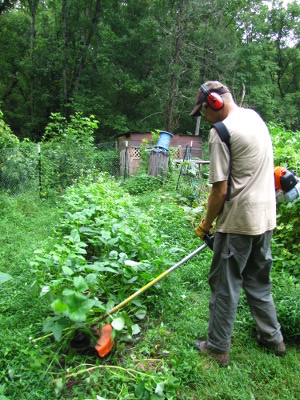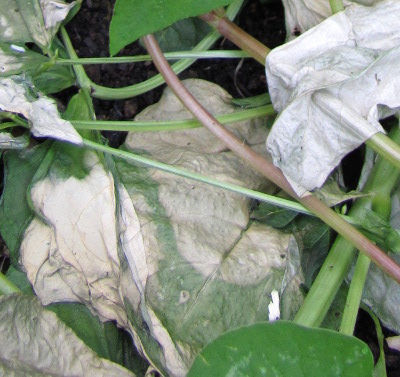
Rest period after cutting cover crops
 I've talked about the C:N ratio here before, and described
the concept in great detail in the July
edition of Weekend Homesteader, so you'd think I would have
realized the ratio has an impact on cover crops. But it took this
in-depth analysis by the North Carolina Extension Service to clue me in.
I've talked about the C:N ratio here before, and described
the concept in great detail in the July
edition of Weekend Homesteader, so you'd think I would have
realized the ratio has an impact on cover crops. But it took this
in-depth analysis by the North Carolina Extension Service to clue me in.
Previously, I've thought
of my cover crops as a way to grow nearly free
mulch for the garden, but summer cover crops have a slightly different
purpose if you want to plant your fall crops amid the cut cover.
The long term goal is still to add organic matter to your soil, but you
want your summer cover crop to melt into the soil quickly rather than
tying up soil nitrogen that will be used by subsequent crops.
10:1 is the magical C:N
ratio at which you don't have to worry about bacteria stealing nitrogen
from the soil to counteract the excessive carbon in your cover
crop. Of course,  none of the cover crops have a
C:N ratio quite that low, so you need to give them a bit of time to
mellow into the soil after you kill them and before planting so that
the C:N ratio can plummet into the recommended range. Legumes and
buckwheat may just need a week or two to decompose enough to allow you
to plant amid the residue while grains/grasses need much more
time. The chart below shows the C:N ratio of some common summer
cover crops immediately after cutting:
none of the cover crops have a
C:N ratio quite that low, so you need to give them a bit of time to
mellow into the soil after you kill them and before planting so that
the C:N ratio can plummet into the recommended range. Legumes and
buckwheat may just need a week or two to decompose enough to allow you
to plant amid the residue while grains/grasses need much more
time. The chart below shows the C:N ratio of some common summer
cover crops immediately after cutting:
| C:N | Nitrogen (lb/ac) | |
| Legumes | .. | .. |
| Cowpeas | 21 | 75 |
| Soybean | 20 | 80 |
| .. | .. | .. |
| Non-legumes | .. | .. |
| Sorghum-sudangrass | 53 | 78 |
| Sudangrass | 44 | 58 |
| Japanese Millet | 42 | 35 |
| Pearl Millet | 50 | 57 |
| German Foxtail Millet | 44 | 43 |
| Buckwheat | 34 | 43 |
Notice that the total
amount of nitrogen produced by the cover crop isn't directly
proportionate to the C:N ratio. A good way of eyeballing the C:N
ratio is to think of how succulent your plants are. If the leaves
feel woody, they're high in carbon and will take a long time to break
down. If they feel soft and fleshy, you've got a low C:N ratio
that probably won't tie up much soil nitrogen.
Want more in-depth information? Browse through our books.
Or explore more posts by date or by subject.
About us: Anna Hess and Mark Hamilton spent over a decade living self-sufficiently in the mountains of Virginia before moving north to start over from scratch in the foothills of Ohio. They've experimented with permaculture, no-till gardening, trailersteading, home-based microbusinesses and much more, writing about their adventures in both blogs and books.
Want to be notified when new comments are posted on this page? Click on the RSS button after you add a comment to subscribe to the comment feed, or simply check the box beside "email replies to me" while writing your comment.

This doesn't really relate to this paost per se, but...I clicked on one of your advertisers and went here:
http://wisefoodchoice.com/selling-words-the-last-days-of-america.htm
It's a bit of a (reasonable given the situation) rant about the USDA now owning the word "organic" -- really??
It reminded of the whole thing about the Dervaes family and the "urban homestead"...
J --- I can't seem to get to that from that link, but I can probably guess what they're saying. I think that back in the early days when "organic" meant something, the growers made a bad choice. They thought that if they all banded together and decided what counted as organic and what didn't and then had farms certified as organic, organic growers could sell their food for a premium and make enough to pay for the more costly growing techniques. Unfortunately, what's really happened (and this is my opinion) is that organic has become nearly as bad as mainstream agriculture because big growers realized they could make money selling "organic" food and just barely achieve the letter of the law without being what you and I would call organic. I think that the real way of getting what you think of as organic food is to grow it yourself or to go talk to a farmer about their actual on-the-ground practices and see if you approve.
Dave V --- I tend to pull out plants like that and give them to the chickens (which also amounts to putting them on the compost pile.) What I didn't mention in this post is that nitrogen fixers, like most other plants, get woodier as they age, and that means a higher C:N that will suck a lot more nitrogen from the soil before it gives any back. The optimal stage for killing a legume and working it directly into the soil is right after flowering and before seed set since the C:N is lowest then. By the time your beans and peas are done fruiting, they're past the point where you could work them directly in, unless you are willing to wait a month or more to plant into the ground again. What you could do with them is use them as a mulch around big plants like tomatoes --- they shouldn't have too high a C:N for that.